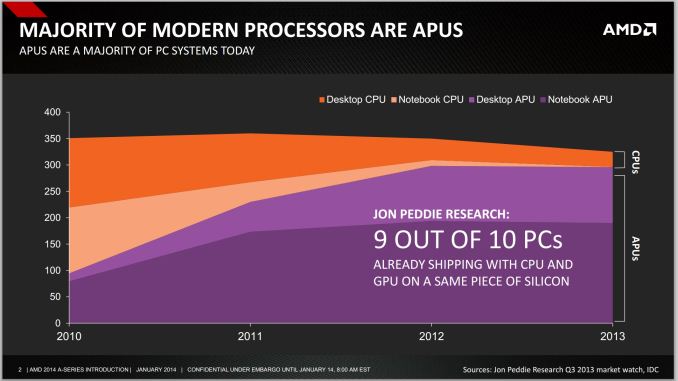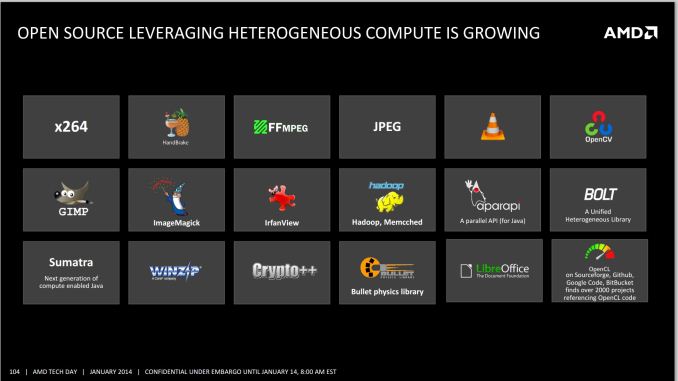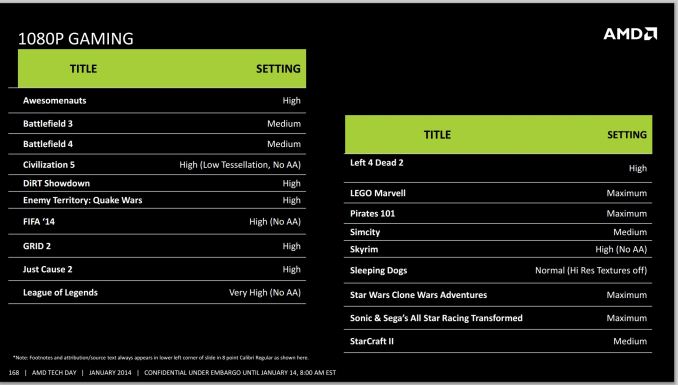AMD Kaveri Review: A8-7600 and A10-7850K Tested
by Ian Cutress & Rahul Garg on January 14, 2014 8:00 AM ESTKaveri: Aiming for 1080p30 and Compute
The numerical differences between Kaveri and Richland are easy enough to rattle off – later in the review we will be discussing these in depth – but at a high level AMD is aiming for a middle ground between the desktop model (CPU + discrete graphics) and Apple’s Mac Pro dream (offloading compute onto different discrete graphics cards) by doing the dream on a single processor. At AMD’s Kaveri tech day the following graph was thrown in front of journalists worldwide:
With Intel now on board, processor graphics is a big deal. You can argue whether or not AMD should continue to use the acronym APU instead of SoC, but the fact remains that it's tough to buy a CPU without an integrated GPU.
In the absence of vertical integration, software optimization always trails hardware availability. If you look at 2011 as the crossover year when APUs/SoCs took over the market, it's not much of a surprise that we haven't seen aggressive moves by software developers to truly leverage GPU compute. Part of the problem has been programming model, which AMD hopes to address with Kaveri and HSA. Kaveri enables a full heterogeneous unified memory architecture (hUMA), such that the integrated graphics topology can access the full breadth of memory that the CPU can, putting a 32GB enabled compute device into the hands of developers.
One of the complexities of compute is also time: getting the CPU and GPU to communicate to each other without HSA and hUMA requires an amount of overhead that is not trivial. For compute, this comes in the form of allowing the CPU and GPU to work on the same data set at the same time, effectively opening up all the compute to the same task without asynchronous calls to memory copies and expensive memory checks for coherency.
The issue AMD has with their HSA ecosystem is the need for developers to jump on board. The analogy oft cited is that on Day 1, iOS had very few apps, yet today has millions. Perhaps a small equivocation fallacy comes in here – Apple is able to manage their OS and system in its entirety, whereas AMD has to compete in the same space as non-HSA enabled products and lacks the control. Nevertheless, AMD is attempting to integrate programming tools for HSA (and OpenCL 2.0) as seamlessly as possible to all modern platforms via a HSA Instruction Layer (HSAIL). The goal is for programming languages like Java, C++ and C++ AMP, as well as common acceleration API libraries and toolkits to provide these features at little or no coding cost. This is something our resident compute guru Rahul will be looking at in further detail later on in the review.
On the gaming side, 30 FPS has been a goal for AMD’s integrated graphics solutions for a couple of generations now.
Arguably we could say that any game should be able to do 30 FPS if we turn down the settings far enough, but AMD has put at least one restriction on that: resolution. 1080p is a lofty goal to hold at 30 FPS with some of the more challenging titles of today. In our testing in this review, it was clear that users had a choice – start with a high resolution and turn the settings down, or keep the settings on medium-high and adjust the resolution. Games like BF4 and Crysis 3 are going to tax any graphics card, especially when additional DirectX 11 features come in to play (ambient occlusion, depth of field, global illumination, and bilateral filtering are some that AMD mention).













380 Comments
View All Comments
Ian Cutress - Tuesday, January 14, 2014 - link
I did a look back to C2D this time last year: http://www.anandtech.com/show/6670/dragging-core2d...When I get into the swing of testing for Gaming CPU viability again, I'll make sure it is part of the testing matrix.
ImSpartacus - Tuesday, January 14, 2014 - link
I've been reading Anadtech since I was in high school and that has to be my favorite article. I reference that article constantly.It's so hard to find reliable & exhaustive benchmarks of old CPUs. If you could update it every 2 years, I would love you forever!
just4U - Tuesday, January 14, 2014 - link
I read that article and it got me to thinking.. Maybe what is needed is not a direct comparison with new and competing products (which companies may not like..) but rather something stand alone that gets refreshed like your E6400 article. It sets the bar on what the reviewer (and likely most of us) think is needed these days..I know for myself I see a lot steps sideways in the computer industry but it's no longer leaps ahead like it once was.alyarb - Wednesday, January 15, 2014 - link
That would be great. I have a C2Q at 3.7 GHz and a 5850 at 800 MHz. Sure, that is >350W under load, but it still gets the job done at 1080p even in 2014. I have tried and can't justify replacing it all just yet.Similarly I'm not surprised to see Llano is not at the bottom of these charts and is still within striking distance of Kaveri in a lot of the tests. One day I'd like to see the past 8 or 10 years of CPUs all put through the same battery of 2013-2014 tests.
Integration and new features are all welcome, but let's take a look, as performance skeptics, at how far we've really come all this time.
anubis44 - Saturday, January 18, 2014 - link
"I have a C2Q at 3.7 GHz and a 5850 at 800 MHz. Sure, that is >350W under load, but it still gets the job done at 1080p even in 2014. I have tried and can't justify replacing it all just yet."Try playing Company of Heroes 2 (my current favourite) on that rig, and understand the meaning of the word 'obsolete'. That game will bring that system to it's knees, and it won't be pretty.
just4U - Sunday, January 19, 2014 - link
Throw in a 760 or a 280x then.. see if it's still brought to it's knees.. Hell a 270/x might do.. it's substantially faster than the 5850 as well.SofS - Friday, January 17, 2014 - link
Careful when comparing older processors regarding the memory subsystem since without the integrated controller they are very sensitive to memory performance or at least my C2Q 9550 @3410MHz seems to be. In my case the upgrade to to a G.Skill F3-12800CL6-2GBXH dual kit I made some years ago was meaningful and some other readers here on similar platforms might find that only upgrading the RAM would give them headroom enough to avoid a whole new system purchase for a while longer. Currently I also own a i7-4800MQ based notebook with dual KHX1600C9S3/8G and while noticeably faster for some cases it does not really enable me to game at higher settings than my desktop system given the GPU being a GTX 765M. Going forward a GPU upgrade to the desktop system is all I am looking for.RussianSensation - Friday, January 17, 2014 - link
Sorry, but you may have a confirmation bias here. You bought new memory expecting the system to perform much faster but years and years of personal ownership of C2D/C2Q systems and online reviews show that it hardly performed faster with faster memory. That architecture in fact performed faster with tighter latency. Your kit doesn't even have 5-5-5-15 timings. C2Q 9550 @ 3.4ghz is a slow CPU compared to Core i7 4770 @ 4.5ghz for gaming. Your memory upgrade may have netted you an extra 2-3% increase on average at best.SofS - Friday, January 17, 2014 - link
Come to think of it, maybe the amount was more important, besides going down to CL6 previously it was 2x1GB instead of 2x2GB. If that is the case then my 765M must be holding the 4800MQ back for gaming or something else is very wrong. Currently the only games I play that do not perform properly at 1080p are Witcher2 and Tomb Raider, probably that has more to do with the GPU than the CPU/RAM tough the real question is if a better next generation mid range GPU would still be able to work properly with them.Albangalo - Wednesday, January 15, 2014 - link
While it's not to do with Kaveri, Tom's Hardware did some articles comparing current cpus with older ones:Intel Ivy vs c2d & c2q: http://www.tomshardware.com/reviews/ivy-bridge-wol...
AMD fx vs k10: http://www.tomshardware.com/reviews/piledriver-k10...